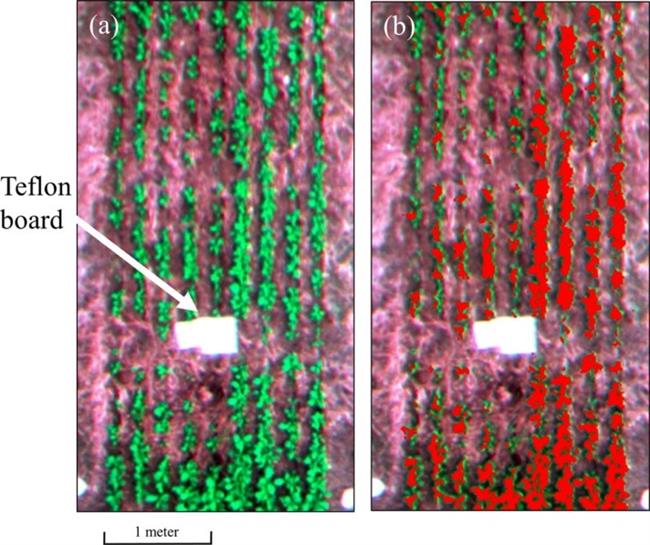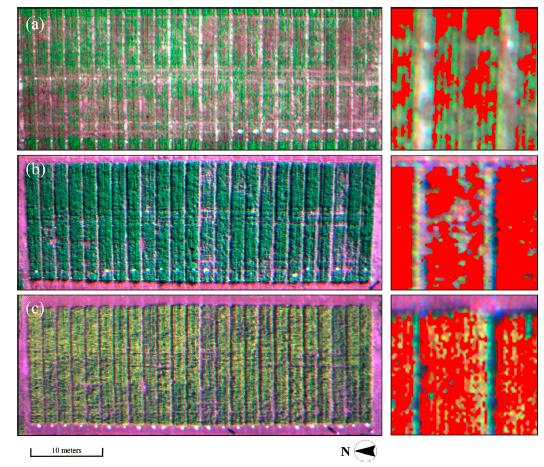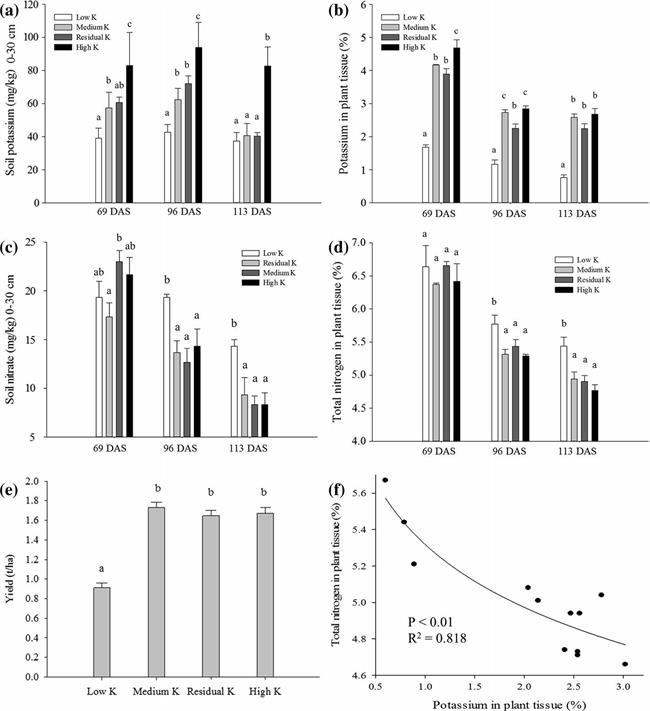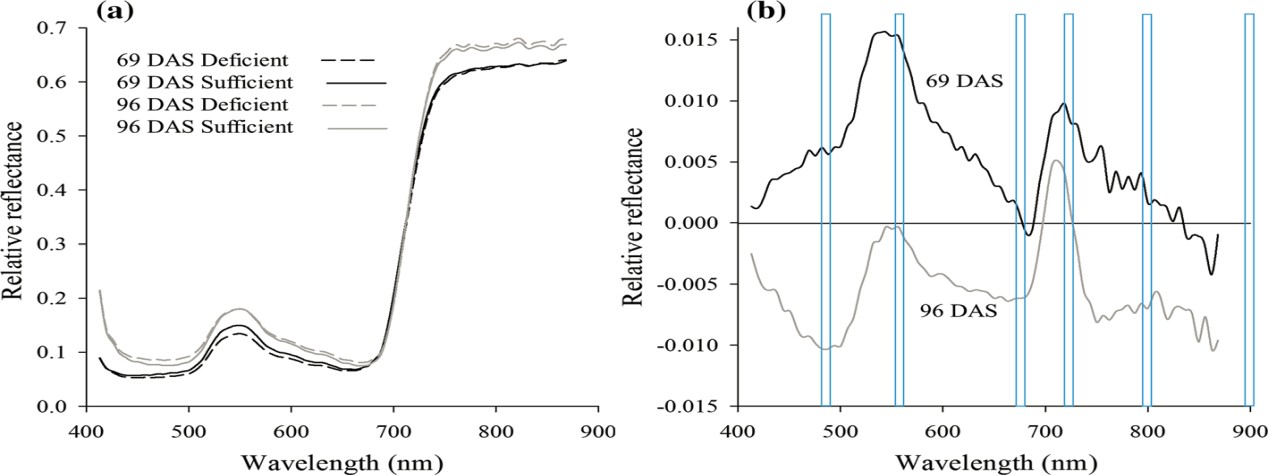Unmanned aerial vehicle canopy reflectance data detecting potassium deficiency and green peach aphid susceptibility in canola
Dustin Severtson 1,2
Nik Callow 3
Ken Flower 4
Andreas Neuhaus 5
Matt Olejnik 6
Christian Nansen 7
1 School of Animal Biology and The UWA Institute of Agriculture, The University of Western Australia, 35 Stirling Highway, Crawley, Perth, WA 6009, Australia
2 Department of Agriculture and Food Western Australia, 3 Baron-Hay Court, South Perth, WA 6151, Australia
3 Environmental Dynamics and Ecohydrology, School of Earth and Environment, The University of Western Australia, 35 Stirling Highway, Crawley, WA 6009, Australia
4 School of Plant Biology and The UWA Institute of Agriculture, The University of Western Australia, 35 Stirling Highway, Crawley, WA 6009, Australia
5 CSBP Limited, Kwinana Beach Road, Kwinana Beach, WA 6167, Australia
6 Sensorem, 1/34 Kings Park Road, West Perth, WA 6932, Australia
7 Department of Entomology and Nematology, UC Davis Briggs Hall, Davis, CA, USA
Summary :
There is growing evidence that potassium deficiency in crops increases their susceptibility to herbivorous arthropods. Remote sensing of the ability of plants to deplete potassium is beneficial to the sampling of arthropods and the spatial optimization of potash, thereby reducing the yield loss caused by arthropods. The soil and plant nutrients were measured in 69 days (seedlings), 96 days (stem elongation), and 113 days (early flowering) in stages. At the same time, multi-spectral images with spatial (pixel) resolution of 8.1 and 65 mm were obtained by applying UAV multi-spectral acquisition techniques at distances of 15 and 120 meters. At 69 and 96 days, wild plants were transported to a laboratory with a controlled light source and hyperspectral imaging of the plants was performed using a 240-channel (390-890 nm) hyperspectral camera. On the 113th day, all the plots were found to be naturally covered with green peach aphids (Hemiptera: Aphididae) and the aphids were counted. It is also known that potassium deficiency in plants causes: (1) increased nitrogen concentration in newly mature leaves (2) increased density of green peach aphids, (3) reduced vegetation cover, (4) reduced normalized vegetation index (NDVI) and rapeseed Production has fallen. According to the analysis, the UAV image with 65 mm spatial resolution has high classification accuracy (72-100%), and the UAV image with 8 mm spatial resolution is lower (69-94%). The classification accuracy of hyperspectral images obtained from wild plants under laboratory conditions is 78-88%. When the non-leaf pixels are removed from the drone data, the spatial resolution obtained in 96 days and 113 days is 8 mm, and the classification accuracy of the 65 mm image is increased. Studies have shown that drone images have the potential to extract vegetation nutrient deficiencies and range of arthropod outbreaks.
Research Background:
1. There is increasing evidence that potassium deficiency in crops increases their susceptibility to herbivorous arthropods. However, traditional plant or soil potassium content testing is time consuming and laborious, and the results are mostly interpolated.
2. The airborne multi/hyperspectral camera technology has been greatly developed. By applying the drone airborne camera to the agricultural survey, the efficiency of the survey can be accelerated and the cost of the survey can be reduced.
3. Canopy reflectance data has been widely used in agricultural yield surveys. However, no studies have investigated the relationship between canopy reflectance data and vegetation potassium content.
Research methods:
Instrument selection:
Pika II (Resonon, USA, indoor)
400-900nm, resolution: 2.1nm, bit depth: 12, frame rate: 60/s
Mini-MCA6 (US Tetracam, airborne)
Weight: 600g, number of channels: 6, image size: 1280 × 1024, size: 115.6 × 80.3 × 68.1 mm
Measurement methods:
Multispectral:
The drones were airborne and photographed at 15 meters and 120 meters above the sample field. The shooting time was from 11 am to 3 pm.
Hyperspectral:
For indoor measurement, three samples from each sample field were moved indoors for measurement.
Soil parameter measurement:
Each sample field was taken to a depth of 0.3 m and a diameter of 35 mm. Three samples were taken from each plot and sent to the CSBP Soil and Plant Analysis Laboratory for measurement.
Number of mites:
Manual counting.
The above measurements were taken simultaneously on days 69, 96, and 113 under rapeseed.
Analytical method:
Multi-spectral data segmentation of rapeseed and soil
15 meters:
Rule: B3<0.4 and B5>0.7
120 meters:
Rule: B3<0.3 and B5>0.45
Analysis of potassium content
1 The only group of rapeseed with the lowest potassium content showed a difference, and only the lowest potassium content produced a decrease in production.
2 Plant nitrogen uptake is inversely proportional to potassium content
Accuracy analysis of potassium deficiency and potassium enrichment
1. The multi-spectral data with a spatial resolution of 65 mm is better than the 8.1 mm data for the vegetation with different effects.
2. The removal of background data has little effect on the accuracy of the spatial resolution of 65 mm data, but it can improve the spatial resolution of 8 mm data.
3. The hyperspectral data reached the highest accuracy on the 69th day, and decreased in 96, 113 days.
4. Selecting the same band as the hyperspectral, the discrimination accuracy will be lower, and the accuracy of the multi-spectral data is lower than that.
Aphid number analysis
The number of aphids in the potassium-deficient vegetation area is more than that of the potassium-free vegetation area, indicating that the lack of potassium in the vegetation will cause the vegetation to resist the aphids.
in conclusion:
1. The paper proposes that the best data for multi-spectral differentiation of potassium-deficient and potassium-rich regions is 65 mm resolution data without background removal (flight altitude is 120 m).
2, remove the background can improve the accuracy of 8.1 mm spatial resolution data
3. The number of aphids in the potassium-deficient vegetation area is higher than that in other areas, indicating that potassium deficiency can reduce the resistance of rapeseed to aphids.
4. This study found that the soil background value has an impact on the differentiation results. Therefore, when doing canopy reflection data analysis, the UAV is used for data acquisition to obtain sufficient background values.
Portable Vet Ultrasound Series
Wireless Ultrasound for animal
XProbe-C Convex, suit for big placenta of cattle and horse
XProbe-L Linear, suit for small placenta of cattle and horse
XProbe-N Suit for sheep
Feature:
· High cost-effective
·Wireless connectivity, easy to operate
·Small and light,easy to carry
Specifications:
-Scanning mode: Electronic array
-Image mode: B, B/M
-Frequency: Convex 3.5MHz/5MHz, Linear 7.5MHz/10MHz
-Scan Depth: Convex 90/130/160/200mm, Linear 20/40/60/100mm
-Probe Radius/Length: Convex R60, Linear L64
-Image Adjust: Gain, DYN, Focus, Depth, Harmonic, Denoise
-Puncture assist function: the function of in-plane puncture guide line, out-of-plane puncture guide line, automatic blood vessel measurement, and the enhancement function of needle point development.
-Cineplay: auto and manual, frames can set as 100/200/500/1000
-Measure: Length, Area, Angle, Obstetrics
-Image frame rate: 18 frames/second
-Image save format: jpg, avi and DICOM
-Battery working time: 6-8 hours
-Charge: by USB
-Length: 800mm
-Weight: 600g
-Wifi type: 802.11g/20MHz/5G/450Mbps
-Working system: Android
Portable Vet Ultrasound,Vet Untrasound Probe,Veterinary Ultrasound Machine Portable,Animal Ultrasounder Scanner
Guangzhou Sonostar Technologies Co., Limited , https://www.sonoeye.com






